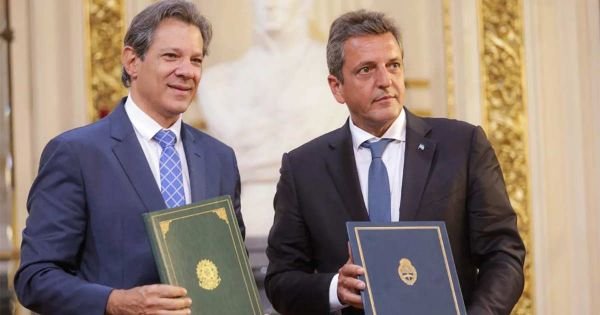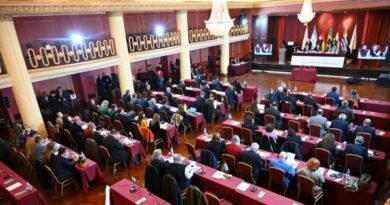New financing deal reached for trade between Argentina and Brazil
[ad_1]
New financing deal reached for trade between Argentina and Brazil
The destiny of Argentina and Brazil are unfailingly tied, Massa told Lula and Haddad (pic)
Argentina’s Economy Minister and presidential candidate Sergio Massa Monday announced after a meeting with his Brazilian colleague Fernando Haddad and with President Luiz Inácio Lula da Silva that an agreement had been reached to finance imports worth US$ 600 million, among other achievements.
After visiting Lula at the Planalto Palace in Brasilia, Massa and Haddad held a press conference, during which the Argentine official highlighted the new step forward in the integration process. It was Massa’s first meeting with Lula and Haddad after Argentina’s entry into the enlarged version of BRICS was announced.
From the physical point of view, because we renewed the Santo Tomé-Sao Borja agreement, which allows us to continue managing with the management and documentation center the whole process of border crossing and logistics facility, said Massa.
We found a mechanism that surpasses the ideas that we had been working on together with Minister Haddad and that were aimed at guaranteeing the Brazilian and Argentine automotive and Brazilian and Argentine food sectors, which are highly integrated, he added.
Every 600 million dollars that Brazil exports to Argentina in automotive matters, are 600 million dollars that come back from Argentina to Brazil in automotive matters due to the assembly and the synergy that their industries have, Massa explained.
The initiative was brokered between both Economy Ministries, and with assistance from the BNDES bank, the Banco do Brasil, and the Latin American Development Bank (CAF).
Argentina and Brazil are indissoluble partners from a commercial and cultural point of view, Massa went on. He also said that the joint initiative between Argentina and Brazil to rebuild their river merchant navies was to be resumed. The Argentine presidential hopeful said that it was a process that Argentina and Brazil had built for 20 years and which had been interrupted under former President Jair Bolsonaro’s government due to Brazil’s decision not to renew the flag reservation agreement.
Massa also praised the huge step that Argentina took by joining the BRICS, which represents 46% of the world’s population and 36% of the world’s GDP.
The destiny of Argentina and Brazil are unfailingly tied because we are the owners of almost 20% of the proteins consumed by the world, Massa also underlined.
The Argentine minister also noted that the financing that was initially intended to be guaranteed via Chinese yuan will finally be guaranteed with financing from CAF for US$ 600 million. On September 14 there will be a meeting of CAF’s Board of Directors to approve the operation, said Massa.
Both ministers also announced the reopening of the poultry market, which had been interrupted due to cases of avian flu: The restrictions were lifted and we are getting back on track, said the Argentine minister.
The new trade agreement between Argentina and Brazil is mainly aimed at maintaining flow in automotive and food products despite Argentina’s troubles accessing foreign currency.
Haddad stressed that although Argentina has reserves in yuan to guarantee Brazilian exports, thanks to CAF’s support it does not have to give up these reserves to guarantee them.
As of Friday [25], CAF became the outbidder for this possibility [yuan guarantee] because of an advantage for Argentina. If Argentina has reserves in yuan to guarantee Brazilian exports, Argentina’s reserves officially go down. And with the support of the CAF, Argentina doesn’t have to give up its reserves to guarantee exports, explained Haddad.
Banco do Brasil will guarantee the exports of Brazilian companies, and CAF will provide a counter-guarantee to Banco do Brasil. There is even a possibility that we won’t even have to use the Brazilian Export Guarantee Fund, which is part of the National Treasury, together with Proex [Export Financing and Guarantee Program], the Brazilian minister added.
Both governments also made progress in the opening of markets in Brazil for peat (natural fertilizer) from Tierra del Fuego; red fruits, plums, and blueberries from the Patagonian region.
[ad_2]
Source link




